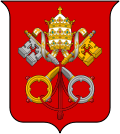
Papal coat of arms
Encyclopedia
For at least 800 years, each Pope
has had his own personal coat of arms
that serves as a symbol of his papacy. The first Pope whose arms are known with certainty is Pope Innocent IV
(1243-1254). Earlier popes were only attributed arms
in the 17th century.
All recent popes' coats of arms contained the image of the papal tiara
. Benedict XVI
has altered heraldic custom and used instead the mitre
and pallium
(see article: Coat of arms of Pope Benedict XVI
). The papal coat of arms traditionally features a gold and silver key, representing the power to bind and to loose on earth (silver) and in heaven (gold). These are a reference to St Matthew's Gospel
, chapter 16, verses 18-19:
Thus in ecclesiastical heraldry
, the keys symbolise the spiritual authority of the Papacy as the Vicar of Christ
on Earth.
Pope
The Pope is the Bishop of Rome, a position that makes him the leader of the worldwide Catholic Church . In the Catholic Church, the Pope is regarded as the successor of Saint Peter, the Apostle...
has had his own personal coat of arms
Coat of arms
A coat of arms is a unique heraldic design on a shield or escutcheon or on a surcoat or tabard used to cover and protect armour and to identify the wearer. Thus the term is often stated as "coat-armour", because it was anciently displayed on the front of a coat of cloth...
that serves as a symbol of his papacy. The first Pope whose arms are known with certainty is Pope Innocent IV
Pope Innocent IV
Pope Innocent IV , born Sinibaldo Fieschi, was pope from June 25, 1243 until his death in 1254.-Early life:...
(1243-1254). Earlier popes were only attributed arms
Attributed arms
Attributed arms are coats of arms given to legendary figures, or to notable persons from times before the rise of heraldry. Beginning in the 12th century, imaginary arms were assigned to the knights of the Round Table, and soon arms were given to biblical figures, to Roman and Greek heroes, and to...
in the 17th century.
All recent popes' coats of arms contained the image of the papal tiara
Papal Tiara
The Papal Tiara, also known incorrectly as the Triple Tiara, or in Latin as the Triregnum, in Italian as the Triregno and as the Trirègne in French, is the three-tiered jewelled papal crown, supposedly of Byzantine and Persian origin, that is a prominent symbol of the papacy...
. Benedict XVI
Pope Benedict XVI
Benedict XVI is the 265th and current Pope, by virtue of his office of Bishop of Rome, the Sovereign of the Vatican City State and the leader of the Catholic Church as well as the other 22 sui iuris Eastern Catholic Churches in full communion with the Holy See...
has altered heraldic custom and used instead the mitre
Mitre
The mitre , also spelled miter, is a type of headwear now known as the traditional, ceremonial head-dress of bishops and certain abbots in the Roman Catholic Church, as well as in the Anglican Communion, some Lutheran churches, and also bishops and certain other clergy in the Eastern Orthodox...
and pallium
Pallium
The pallium is an ecclesiastical vestment in the Roman Catholic Church, originally peculiar to the Pope, but for many centuries bestowed by him on metropolitans and primates as a symbol of the jurisdiction delegated to them by the Holy See. In that context it has always remained unambiguously...
(see article: Coat of arms of Pope Benedict XVI
Coat of arms of Pope Benedict XVI
The coat of arms of Pope Benedict XVI was designed by then Archbishop Andrea Cordero Lanza di Montezemolo soon after the papal election. The coat of arms consists of a shield and external ornaments.-Shield:...
). The papal coat of arms traditionally features a gold and silver key, representing the power to bind and to loose on earth (silver) and in heaven (gold). These are a reference to St Matthew's Gospel
Gospel
A gospel is an account, often written, that describes the life of Jesus of Nazareth. In a more general sense the term "gospel" may refer to the good news message of the New Testament. It is primarily used in reference to the four canonical gospels of Matthew, Mark, Luke, and John...
, chapter 16, verses 18-19:
- "You are PeterSaint PeterSaint Peter or Simon Peter was an early Christian leader, who is featured prominently in the New Testament Gospels and the Acts of the Apostles. The son of John or of Jonah and from the village of Bethsaida in the province of Galilee, his brother Andrew was also an apostle...
, and upon this rock I will build my church, and the gates of hell shall not prevail against it. I will give you the keys to the kingdom of heaven. Whatever you bind on earth shall be bound in heaven; and whatever you loose on earth shall be loosed in heaven."
Thus in ecclesiastical heraldry
Ecclesiastical heraldry
Ecclesiastical heraldry is the tradition of heraldry developed by Christian clergy. Initially used to mark documents, ecclesiastical heraldry evolved as a system for identifying people and dioceses. It is most formalized within the Catholic Church, where most bishops, including the Pope, have a...
, the keys symbolise the spiritual authority of the Papacy as the Vicar of Christ
Vicar of Christ
Vicar of Christ is a term used in different ways, with different theological connotations throughout history...
on Earth.
Related coats of arms
 Coat of Arms of the Holy See Holy See The Holy See is the episcopal jurisdiction of the Catholic Church in Rome, in which its Bishop is commonly known as the Pope. It is the preeminent episcopal see of the Catholic Church, forming the central government of the Church. As such, diplomatically, and in other spheres the Holy See acts and... . |
 Coat of Arms of Vatican City Vatican City Vatican City , or Vatican City State, in Italian officially Stato della Città del Vaticano , which translates literally as State of the City of the Vatican, is a landlocked sovereign city-state whose territory consists of a walled enclave within the city of Rome, Italy. It has an area of... . |
| Emblem of Vatican City (from the Flag Flag of the Vatican City The flag of Vatican City was adopted on June 7, 1929, the year Pope Pius XI signed the Lateran Treaty with Italy, creating a new independent state governed by the Holy See... ). |
 Sede vacante Sede vacante Sede vacante is an expression, used in the Canon Law of the Catholic Church, that refers to the vacancy of the episcopal see of a particular church... emblem of Holy See, used when there is no reigning pope. Keys disposed as customary for Papal arms, not Vatican City, at least since 1929 |

